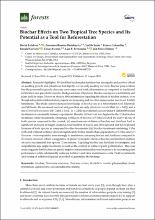Por favor, use este identificador para citar o enlazar este ítem:
https://hdl.handle.net/20.500.12921/412Registro completo de metadatos
| Campo DC | Valor | Lengua/Idioma |
|---|---|---|
| dc.contributor.author | Lefebvre, David | - |
| dc.contributor.author | Román Dañobeytia, Francisco | - |
| dc.contributor.author | Soete, Judith | - |
| dc.contributor.author | Cabanillas, France | - |
| dc.contributor.author | Corvera Gomringer, Ronald | - |
| dc.contributor.author | Ascorra, César | - |
| dc.contributor.author | Fernández, Luis E. | - |
| dc.contributor.author | Silman, Miles | - |
| dc.date.accessioned | 2019-11-19T21:21:40Z | - |
| dc.date.available | 2019-11-19T21:21:40Z | - |
| dc.date.issued | 2019-08 | - |
| dc.identifier.citation | Forests, 10(8): 678 Lefebvre, D., Román-Dañobeytia, F., Soete, J., Cabanillas, F., Corvera, R., Ascorra, C., ... & Silman, M. (2019). Biochar effects on two tropical tree species and its potential as a tool for reforestation. Forests, 10(8), 678. | es_ES |
| dc.identifier.issn | 1999-4907 | - |
| dc.identifier.uri | https://hdl.handle.net/20.500.12921/412 | - |
| dc.identifier.uri | https://doi.org/10.3390/f10080678 | - |
| dc.description.abstract | An indigenous farming technique that's been around for thousands of years provides the basis for restoring rain forests stripped clear of trees by gold mining and other threats. A carbon-based soil amendment called biochar is a cheap and effective way to support tree seedling survival during reforestation efforts in the Amazon rain forest. Restoring and recovering rain forests has become increasingly important for combating climate change, since these wide swaths of trees can absorb billions of tons of carbon dioxide each year. The problem is particularly acute in areas mined for alluvial gold deposits, which devastate not only rain forest trees but also soils. High costs can be a huge barrier to replanting, fertilizing and nurturing trees to replace those lost in the rain forest. Using biochar combined with fertilizer significantly improved height and diameter growth of tree seedlings while also increasing the number of leaves the seedlings developed. The experiment, based in a Peruvian Amazon region of Madre de Dios, the heart of illegal gold mining trade in that country, used two tropical tree species: the fast-growing Guazuma crinita and Terminalia amazonia, a late successional tree often used as timber. | es_ES |
| dc.format | application/pdf | es_ES |
| dc.language.iso | eng | es_ES |
| dc.publisher | MDPI Publishing | es_ES |
| dc.relation | info:eu-repo/semantics/article | es_ES |
| dc.relation.uri | https://www.mdpi.com/1999-4907/10/8/678 | es_ES |
| dc.rights | info:eu-repo/semantics/restrictedAccess | es_ES |
| dc.rights.uri | http://creativecommons.org/licenses/by-nc-nd/2.5/pe/ | es_ES |
| dc.source | Instituto de Investigaciones de la Amazonía Peruana | es_ES |
| dc.source | Repositorio Institucional - IIAP | es_ES |
| dc.subject | Reforestación | es_ES |
| dc.subject | Carbón vegetal | es_ES |
| dc.subject | Terminalia amazonia | es_ES |
| dc.subject | Guazuma crinita | es_ES |
| dc.subject | Bertholletia excelsa | es_ES |
| dc.subject | Fenotipos | es_ES |
| dc.subject | Rehabilitación forestal | es_ES |
| dc.subject | Restauración del paisaje forestal | es_ES |
| dc.subject | Conservación de suelos | es_ES |
| dc.subject | Minería | es_ES |
| dc.subject | Amazonía | es_ES |
| dc.subject | Madre de Dios | es_ES |
| dc.title | Biochar effects on two tropical tree species and its potential as a tool for reforestation | es_ES |
| dc.type | info:eu-repo/semantics/article | es_ES |
| dc.identifier.journal | Forests | es_ES |
| dc.description.peer-review | Revisión por pares | es_ES |
| dc.identifier.doi | 10.3390/f10080678 | es_ES |
| Aparece en las colecciones: | Artículos en revistas indexadas | |
Ficheros en este ítem:
| Fichero | Descripción | Tamaño | Formato | |
|---|---|---|---|---|
| Lefebre_articulo_2019.pdf Until 2039-12-01 | Texto Completo | 1,41 MB | Adobe PDF |  Visualizar/Abrir Request a copy |
Compartir :
Este ítem está sujeto a una licencia Creative Commons Licencia Creative Commons




